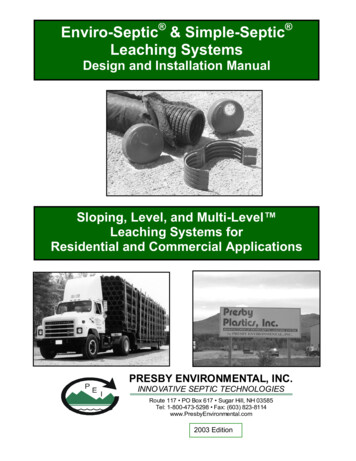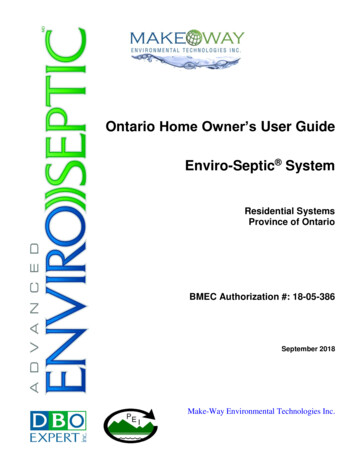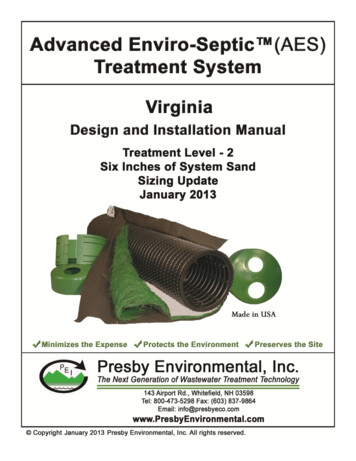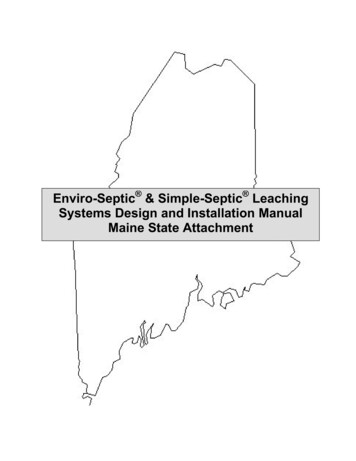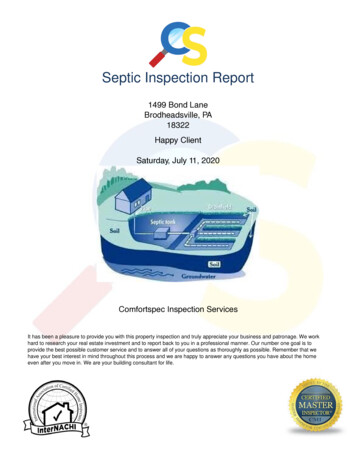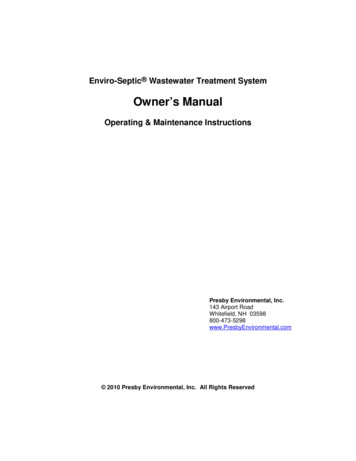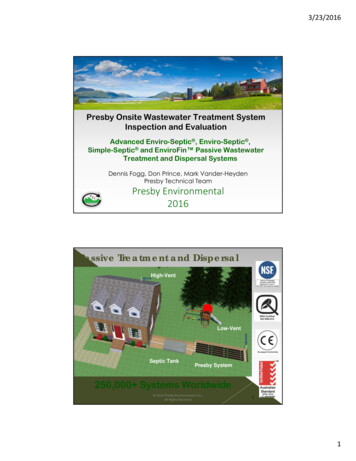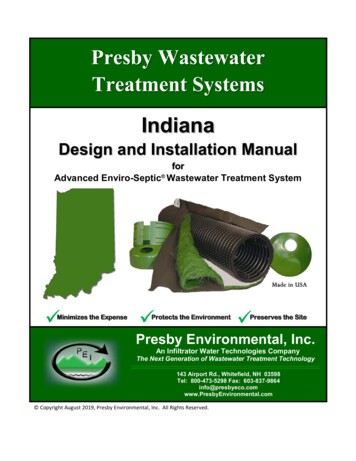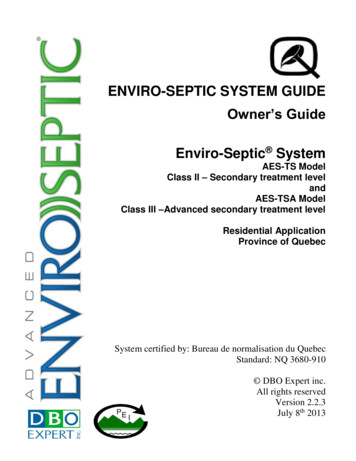
Transcription
ENVIRO-SEPTIC SYSTEM GUIDEOwner’s GuideEnviro-Septic SystemAES-TS ModelClass II – Secondary treatment levelandAES-TSA ModelClass III –Advanced secondary treatment levelResidential ApplicationProvince of QuebecSystem certified by: Bureau de normalisation du QuebecStandard: NQ 3680-910 DBO Expert inc.All rights reservedVersion 2.2.3July 8th 2013
User’s Guide –Enviro-Septic SystemImportant Security instructionsIt is extremely dangerous even potentially deadly to open a septic tank,pumping station or any enclosed space that is part of a wastewater treatmentsystem. This work must be done by a person trained in enclosed spaceworking and rescue procedures who has the necessary equipment.The action of the bacteria on the organic matter present in the wastewaterproduces gases such as carbon gas (CO2), methane gas (CH4) and sulphurichydrogen (H2S). The H2S present in the septic tank or a pumping station cancause the death of an individual in a matter of minutes. This is why this workmust be left to competent personnel.Pipes are buried near your septic installation. Please speak to your contractoror the technical service of DBO Expert inc. in order to take the necessaryprecautions before digging or undertaking excavation jobs near your septicsystem.Please be sure that the covers of the septic tank, pumping station, piezometersand sampling device are always in place and that they remain accessible at alltimes for periodic inspections and interventions when necessary. (e.g.emptying of the septic tank). The same applies for distribution boxes ofsystems built after 2009 as well as those which had an accessible distributionbox before that time.Advanced Enviro-Septic comes with a manufacturer’s limited warranty. Thewarranty details are presented in Appendix A.Advanced Enviro-Septic U.S. Patent numbers. 6,461,078; 5,954,451; 6,290,429;6,899,359; 6,792,977; 7,270,532 and 5,606,786. Other patent pending.Enviro-Septic is a trademark of Presby Environmental, Inc.Advanced Enviro-Septic is a trademark of Presby Environmental, Inc.Bio-Accelerator is a trademark of Presby Environmental, Inc.July 30th, 20131
User’s Guide –Enviro-Septic SystemTable of ContentsIntroductionThe purpose of this documentDesignation of the Enviro-Septic SystemDefinition of the Enviro-Septic SystemWhat to do if a problem occurs?Customer service and Technical support informationSystem tagCertified ContractorEnviro-Septic System CapacityResidential WastewaterWarranty certificateFunctioning of the Enviro-Septic SystemTreatment process of the Enviro-Septic systemDiagram of the Enviro-Septic chain of treatmentEnviro-Septic System ComponentsOperating the Enviro-Septic SystemInitial UseIntermittent Use or Prolonged AbsencesEnviro-Septic System Operating InstructionsWastewater VolumeIn the bathroomIn the kitchenFor the laundryElsewhere in and around the houseChemicals for septic installationVentilationHeavy machinery and motorized vehicle trafficVegetationEnviro-Septic System MaintenanceDistribution box and flow equalizerEmbankment surface above the Enviro-Septic SystemOwner’s ResponsibilitiesMeasuring the Water Levels in the PiezometersWhat to do if water level is highAppendix A- Presby Twenty Year Limited WarrantyAppendix B - Information Specific to Your Treatment SystemAppendix C – Register of the height of water in the piezometersAppendix D – Register of the Septic Tank MaintenanceJuly 30th, 72021222324252627
User’s Guide –Enviro-Septic SystemIntroductionCongratulations! You have chosen the Enviro-Septic System for your septicinstallation. This system was developed to efficiently treat domesticwastewater. However, instructions must be followed in order to maintain itstreatment performance so that you can make use of it for many years.We ask that you carefully read through this document and keep it in your filesfor future reference.The purpose ofthis documentThis user guide explains the proper use, procedures and inspections requiredin order to ensure the proper operation and longevity of an Enviro-SepticSystem for residential wastewater treatment.Please note that it is the owner’s responsibility to ensure that the system isused properly and according to its treatment capacity. It is also hisresponsibility to respect the rules and regulations in effect, especially the Lawof the quality of Environment and the Q-2, r.22 regulation1 on wastewatertreatment and evacuation.Designation ofthe EnviroSeptic SystemName: Enviro-Septic SystemModel: ESP-TSA and ESP-TSApplication Domain: Residential Wastewater (sewage).Class and treatment type: The Enviro-Septic system meets all therequirements of the NQ 3680-9102 standard for class III – advancedsecondary treatment systems or class II – secondary treatment systems inQuebec.The system cannot be used to treat wastewater to make it consumable. It ismade to treat residential wastewater to an acceptable level for it to bereintroduced into the environment according to the criteria prescribed in theQ-2, r.22.1The Q-2, r.22 regulation was previously known as the Q-2, r.8. It is available on the Quebec Government site of the“Ministère du Développement durable de l’Environnement et des Parcs”, at the address: www.mddep.gouv.qc.ca/eau/eauxusees or through the “Publication du Québec”2NQ 3680-910 standard, Wastewater treatment – Stand-Alone Wastewater Treatment Systems for isolated Dwellings,Bureau de Normalisation du Québec, 2000-06-16July 30th, 20133
User’s Guide –Enviro-Septic SystemDefinition ofthe EnviroSeptic SystemThe Enviro-Septic system is a passive technology that facilitates the growthof bacteria responsible for wastewater treatment. It is composed primarily oftwo inseparable components: the rows of Advanced Enviro-Septic pipe and alayer of system sand.The Enviro-Septic system must be preceded by a septic tank and a wastewaterdistribution device. The treated water is drained directly into the soil beneaththe treatment system through a soil absorption system as described in the Q-2,r.22 regulation: a leaching field for class II systems or a polishing leachingfield for class III systems. They can also be discharged directly to a river ifthis type of discharge is allowed.What to do if aproblemoccurs?If in the course of normal use of your septic system you notice any of thefollowing problems: Presence of abnormal odours in the house, around the septic system oremanating from sources of drinking water.Abnormally wet soil, presence of persistent puddles or odours in thearea of the septic tank or the Enviro-Septic system.Slow flushing toilets or other plumbing in the home.Presence of abnormally abundant vegetation on the surface or aroundthe septic tank or the Enviro-Septic system installation.Flooding in the area where the Enviro-Septic system is installed.Erosion of the land fill on or around the Enviro-Septic system.Alarm from the pumping station if such a device is part of yourinstallation.If you notice one of these problems, immediately contact your contractor orthe customer service of DBO Expert Inc. 1-866-440-4975. Please haveavailable the information from Appendix B – Information Specific to YourTreatment System – of the present guide.Warning: Please note that the situations described above can affect anyseptic system, whether it is an Enviro-Septic system, any other certifiedwastewater treatment technology or any soil absorption systems prescribed inthe Q-2, r.22 regulation. When these problems occur, they are usually causedby poor installation, malfunction of the residence plumbing, extreme weatheror geological factors or surface water flowing into the septic system.Customerservice andTechnicalsupportinformationJuly 30th, 2013Please contact us if you need further information.Telephone: 1-866-440-4975 or (819) 846-3642Fax: (819) 846-2135Email: info@dboexpert.comInternet site: www.enviro-septic.com4
User’s Guide –Enviro-Septic SystemSystem tagEach Enviro-Septic system must be identified with a specific system tag. Thistag, similar to the one shown in figure 1, will be installed in the samplingdevice access port. It will be added during the installation of the system. Thenumber shown at the bottom of the tag will help to identify your system.The class of the system in place is indicated on the system tag.Fig. 1CertifiedContractorJuly 30th, 2013The Enviro-Septic System must be installed by a contractor previously trainedby DBO Expert or one of its representatives to obtain a certificate ofauthorised installer. The customer service of DBO Expert can provide thename of contractors having the proper authorisation to install Enviro-SepticSystems.5
User’s Guide –Enviro-Septic SystemEnviro-SepticSystemCapacityThe capacity of the Enviro-Septic System depends on two elements : The number of Advanced Enviro-Septic Pipes The capacity of the underlying soil to evacuate the treated water.Tables 1 and 2 present the capacity of each system in relation with thenumber of pipes installed for a 1 to 6 bedroom residence or other buildingwith a daily flow of 3240 L/d or less. The total volume of wastewater fed tothe system must not be more than what is shown in the table.The system may also be limited by the capacity of the underlying soil topermit the infiltration and evacuation of wastewater. This value should beevaluated by the designer mandated to create the plans and estimates for yourseptic installation. It is, therefore, important to verify with the designer if thecapacity of the soil permits complete infiltration and evacuation of themaximum amount of water able to be treated by the pipes installed.Table 1 –Enviro-Septichydrauliccapacity basedon the numberof bedrooms ofan isolateddwellingNumber ofbedroomsMinimum Number ofAdvanced Enviro-Septic Pipes(3.05 m each)Minimum TotalLength of AdvancedEnviro-Septic Pipes(m)Maximum HydraulicCapacity 108012601440180021603The hydraulic capacities shown in table 1 are the same shown in the Q-2, r.22 regulation for 1 to 6 bedroom isolateddwellings (clause 1.3). The difference between the minimum number of Advanced Enviro-Septic pipe for a similar daily flowbetween table 1 and 2 come after different security factors that are associated with 1 to 6 bedroom house vs other types ofbuildings.July 30th, 20136
User’s Guide –Enviro-Septic SystemTable 2 –Enviro-Septichydrauliccapacity basedon the numberof pipesinstalled foranother type ofbuildingResidentialWastewaterTable 3Maximum DailyFlow(L/d)Number of AdvancedEnviro-Septic Pipes(3.05 m each)Total Length ofAdvanced EnviroSeptic Pipes 09,8115,9122,0Table 3 indicates the normal characteristics of raw domestic sewage.ParameterUnitsRaw SewageTSSCBOD5Fecal Coliformmg/Lmg/LCFU/100 ml237-600210-530106-1010Septic TankEffluent50-90140-200103-106Source: Tchobanoglous and Burton (1991)WarrantycertificateJuly 30th, 2013Advanced Enviro-Septic comes with a manufacturer’s limited warranty. Thewarranty details are presented in Appendix A.7
User’s Guide –Enviro-Septic SystemFunctioning of the Enviro-Septic SystemTreatmentprocess of theEnviro-SepticsystemThe rows of Advanced Enviro-Septic pipes and system sand permit thetreatment and distribution of wastewater on the surface of the receiving soil(surface of the polishing leaching field or the leaching bed).The pipes support, first of all, the separation of particles through flotation anddecantation. The water is then evacuated through perforations situated allaround the pipes and through the pores of the three layers of synthetic mediacovering the pipes. These membranes facilitate the fixation of the microbialcultures which support wastewater treatment as well as longitudinaldistribution.The layer of sand continues the treatment process and helps in dispersing thewater before it infiltrates into the natural soil. In this way, the Enviro-Septicsystem integrates both functions of treatment and evacuation.Diagram of theEnviro-Septicchain oftreatmentThe chain of treatment varies according to the method of discharge used.Figures 2.1 to 3.2 show the different options possible.Underground evacuationFigures 2.1 and 2.2 show the progress of the water along the complete chainof treatment for a system using underground evacuationFig. 2.1 - Secondary Treatment SystemRawSewageSeptic tic SecondaryLevel Treatment SystemSoil Absorption Field,Seepage Bed or AboveGround Sand FilterInfiltration in the groundFig. 2.2 - Advanced Secondary Treatment SystemRawSewageSeptic tic Secondary AdvancedLevel Treatment SystemPolishing Leaching FieldInfiltration in the groundJuly 30th, 20138
User’s Guide –Enviro-Septic SystemDischarge to a Stream or RiverFigures 3.1 and 3.2 show the progress of the water in the complete treatmentchain of a system using a direct discharge to a waterway.Fig. 3.1 - Secondary Treatment SystemRawSewageSeptic TankDistributionDeviceEnviro-Septic SecondaryLevel Treatment SystemStandard Sand Filter BedWater Collection SectionTreated Effluent in Accordance with the Q-2, r.22 RegulationFig. 3.2 - Advanced Secondary Treatment SystemRawSewageSeptic TankDistributionDeviceEnviro-Septic Secondary AdvancedLevel Treatment SystemWater Collection SectionTreated Effluent in Accordance with the Q-2, r.22 RegulationJuly 30th, 20139
User’s Guide –Enviro-Septic SystemEnviro-Septic System ComponentsYour septic installation includes several components. All of these componentsare part of the chain of treatment of your installation. Table 4 presents the listof these elements. However it should be noted that some of these are onlyused when site conditions require them.The table also presents a summary of inspections required for eachcomponent. More detailed information on this subject is presented in thesections that follow.Fig. 4 - Diagram of the Enviro-Septic systemEnviro-Septic Treatment SystemSystem SandPipe Offset AdapterRow of Advanced Enviro-Septic PipesPipe CouplingsPipe Double Offset AdapterEnviro-Septic PipeExit VentVentilation pipes connected to a ventPiezometersTop soil with grassSeptic TankDistribution Device(e.g. Distribution Box)PolishingLeaching FieldRock, Clay or WatertableWater infiltrationJuly 30th, 201310
User’s Guide –Enviro-Septic SystemTable 4 - Enviro-Septic System ComponentsComponents of theseptic systemFunctionFollow-upneededSeptic tankPrimary wastewatertreatmentPeriodic emptyingSeptic Tank EffluentFilter4To retain solids largerthan the maximumopenings of the filter.Distribution systems3 optionsA) Distributionbox and flowequalizersB) Pressuredistribution(feed) systemC) AutomaticdistributingvalveRows of AdvancedEnviro-Septic Pipes.PiezometersSampling deviceVentSystem sandPumping station(optional)To distribute the septictank effluent to the rowsof Advanced EnviroSeptic .FrequencyResponsible forfollow-upAccording toOwner is resstandards andponsible to haveregulations inwork done byeffectqualified personAccording to manufacturer’s instructions.A) According towater level in thepiezometersA) As neededA) OwnerB) According to the manufacturer’s directions.C) According to the manufacturer’s directions.To distribute and treatwastewaterTo indicate the level ofwater in the rows ofpipes.See piezometersTo verify the treatmentperformance of theEnviro-Septic SystemTo allow the circulationof air in the EnviroSeptic SystemTo complete the watertreatment process and toimprove the drainageTo lift septic tankeffluent to the EnviroSeptic SystemEnsure that thereis access to thisdeviceEnsure that theopening is notblockedNoMeasure waterlevelsOnce or twice ayear as apreventivemeasure, beforeemptying theseptic tankOptionalOwner orqualified personAs neededOwnerQualified personAccording to supplier’s specifications4The effluent filter is necessary whenever the septic tank is followed by a low pressure distribution system. It is alsomandatory in all BNQ certified septic tanks made since January 1 st, 2009.July 30th, 201311
User’s Guide –Enviro-Septic SystemOperating the Enviro-Septic SystemInitial UseAt the time of installation, the septic tank must be filled with clear water.If a pumping station is used, the contractor will verify that it is functioningproperly at the time of installation. The home owner must make sure thatthere is adequate electricity to safely operate the equipment as well as thealarm component.The Enviro-Septic system is now ready for use.IntermittentUse orProlongedAbsencesJuly 30th, 2013The Enviro-Septic system is a passive wastewater treatment system. Whenproperly installed, it requires no particular attention for intermittent use or inthe case of prolonged absence.12
User’s Guide –Enviro-Septic SystemEnviro-Septic System Operating InstructionsThe use and the maintenance of an Enviro-Septic System are relativelysimple. In general, use of a reasonable amount of water in the residence andrespecting the following rules will allow you use of your installation withoutproblems for years to come.In the following paragraphs, you will find the basic rules to follow to ensureproper functioning of your Enviro-Septic System. For more details on thistopic, please consult the website of the MDDEFP and more specifically theGood Practice Guide for owners of wastewater treatment systems5. You willsee that the following rules are essential to the proper functioning of anyseptic system, regardless of the technology used.To simplify understanding, these rules are presented to you as things to do ornot to do in each part of the house and outside around the house.WastewaterVolumeLarge quantities of water that leave the house and enter the Enviro-SepticSystem in a short period of time could have a negative impact on theeffectiveness of the treatment and the infiltration of wastewater. Largequantities of water can cause agitation in the septic tank. A certain quantity ofsludge or scum is likely to be put into suspension and be brought towards theEnviro-Septic system and the infiltration bed. The frequency of such eventsmust be minimized.You must ensure that the volume of wastewater entering the septic tank andflowing into the Enviro-Septic System is reasonable when compared to thetotal daily flow the system was designed for.After the installation, if changes are made to the residence (ex. addition of abedroom)6, please contact the designer of the Enviro-Septic System. Makesure that the septic system is inspected by a qualified person to determine thatit has the necessary capacity to treat and infiltrate the new daily design flowof wastewater being generated.5Ministry of Sustainable Development, Environment, Wildlife and Parks, Good Practice Guide for owners ofwastewater treatment systems - June 2011 http://www.mddep.gouv.qc.ca/eau / fs.pdf6Adding a bedroom, a business at home, a reception room, conversion of the house to a bed and breakfast, etc.July 30th, 201313
User’s Guide –Enviro-Septic SystemIn thebathroomDo: Immediately repair any leaking faucet or toilet.Use a reasonable quantity of toilet paper.Do not : Use disinfectant in tablet (puck) form, whether it is placed in the basinor the tank. Throw cigarettes, cigarette butts or medication in the toilet. Throw paper towels, paper napkins or other personal hygiene productsin the toilet.In the kitchenDo: Repair any leaking faucet. Use dish soap or dishwasher soap that is low in phosphate (0 to 5%). Use the necessary quantity of soap to do the work. Take note that thenecessary quantity is often less than suggested by the manufacturer.Do not : Use a food waste disposal unit in your sink that is connected to yourseptic installation. Dispose of vegetables, meats, fat, oil, coffee beans, or other unassimilatedproducts into the septic system.For the laundryDo: Use phosphate free detergent, preferably in liquid form. If it is notpossible, use biodegradable powder detergent. Use the necessary quantity of soap to do the work. Take note that thenecessary quantity is often less than that suggested by the manufacturer. Minimize, when possible, the volume of water used for the laundryaccording to the quantity of clothing to wash. If possible, spread your loads of laundry throughout the week asrecommended by MDDEFP for any septic installation7.7Ministry of Sustainable Development, Environment, Wildlife and Parks, Good Practice Guide for owners ofwastewater treatment systems - June 2011 http://www.mddep.gouv.qc.ca/eau / fs.pdfJuly 30th, 201314
User’s Guide –Enviro-Septic SystemElsewhere inand around thehouseDo: Divert drainage and rain water away from the surface of the AdvancedEnviro-Septic System.Do not : Discharge water softener backwash into your septic system. Discharge any water from swimming pool filters, spas or other appliancesthat discharge chlorinated water into your septic system. Let water from sump pumps, roof drains (gutters) and drainage pipesdischarge into the septic system. Dispose of solvents, paints, antifreeze, engine oil, floor waxes, carpetcleaners, drain cleaner or other toxic or flammable products in the septicinstallation. This includes water used to wash brushes or rollers that wereused with latex paint (latex paint contains elements that are harmful to theseptic systems). Dispose of animal litter, tea bags, coffee grounds, egg shells, cigarettebutts, paper towels, condoms, diapers or sanitary napkins in the septicinstallation.Chemicals forsepticinstallationYour Enviro-Septic System does not require any starting chemical, cleaningor other additives. The bacteria that carry out the treatment are naturallypresent in raw domestic sewage. Any chemicals or additives added to theEnviro-Septic System could possibly kill these bacteria.VentilationIt is very important to ensure that good ventilation occurs so that the septicsystem functions correctly. The vent(s) installed at the ends of the septicsystem encourage this air circulation. It is important to make sure that theopening is not blocked and that air can circulate freely at all times. Air entersthrough the vent, circulates through the rows of pipes and the septic tank andtravels through the plumbing of the house to exit through the roof vent.The owner must be sure to have a roof vent and to keep it clear at all times.When a pumping station is used, a bypass pipe or an extra vent must be usedto ensure proper ventilation of the system.July 30th, 201315
User’s Guide –Enviro-Septic SystemHeavymachinery andmotorizedvehicle trafficNo heavy machinery must be driven on a septic system, whether it is before,during or after its construction. This includes any motorized vehicle. Theeffectiveness of the drainage in the ground depends on the presence of a noncompacted natural soil that is not saturated with water. Heavy machinery ormotorized vehicle traffic8 on the soil closes the natural pores of the soil whichreduces its permeability and allows for pounding and the accumulation ofwater.VegetationThe surface of the septic system must be planted with grass. The grass mustbe cut regularly in order to encourage growth without the use of fertilizers.Vegetation cover contributes to the elimination of nitrogen and phosphorus.It is important not to plant trees or other plants with invasive roots within theproximity of the septic installation (minimum distance 3 meters).8The Advanced Enviro-Septic pipes installed according to manufacturer's recommendations can withstand theweight of a vehicle not exceeding the standard H10, if such a vehicle were to move above the treatment system. Theoccasional passage of a light vehicle such as a lawn tractor, is acceptable.July 30th, 201316
User’s Guide –Enviro-Septic SystemEnviro-Septic System MaintenanceSeptic TankMaintenanceThe septic tank preceding the Enviro-Septic System must be pumped outregularly. Article 13 of the Q-2, r.22 regulation requires that it is pumped outevery two years for normal residential use or every four years for seasonalapplications. For more information on septic tank maintenance, verify thecurrent regulation, or get in touch with the municipal authorities.If the septic tank is not emptied regularly, an increasingly large amount ofsolids and grease in suspension will leave the septic tank and end up in thetreatment system. The septic tank will no longer function properly and in timethe performance of the Enviro-Septic System may be affected. This is whyperiodic emptying of the septic tank is necessary.At all times, a professional using the proper equipment must carry out thepumping out of a septic tankThe owner is responsible to ensure his septic tank is pumped outaccording to local regulations. This work should always be done by aqualified person since it can be very dangerous to open a septic systemwithout first taking the necessary precautions.Note: It is the home owner’s responsibility to make sure that at all timesthe septic tank lids are in their proper position and securely fastened. Alid that is not installed correctly can be harmful to the operation of theEnviro-Septic System.Pre-filter(Septic tankeffluent filter)The effluent filter is a device normally used at the exit of the septic tank9. It ismandatory when a low pressure distribution system is used between the septictank and the Advanced Enviro-Septic pipes.The effluent filter must be cleaned according to the maintenance andinspection procedures provided by the manufacturer.Distributionbox and flowequalizerDuring normal use of your septic system the distribution box and the flowequalizers do not need adjustment. The initial levelling during installation andthe self-levelling capability of the flow equalizers are generally enough tomaintain an equal distribution of water among the rows of Advanced EnviroSeptic pipe. However, a difference of more than 100 mm between the lowestand highest water level in the piezometers for two consecutive measurementsindicates that the equalizers may need adjustment. A qualified person mustthen carry out the adjustment(s).9The effluent filter is necessary whenever the septic tank is followed by a low pressure distribution system. It is alsomandatory in all BNQ certified septic tanks made since January 1 st, 2009.July 30th, 201317
User’s Guide –Enviro-Septic SystemAdvancedEnviro-Septic Pipe RowsUnder normal use, the rows of Advanced Enviro-Septic pipes do not requiremaintenance. It is normal to find fluctuation of the water level in the pipes.On the other hand, if the water level reaches 260 mm, a rejuvenation of theEnviro-Septic System must be considered. A qualified person10 must carryout this procedure.PiezometersNo maintenance is required on the piezometers. However, the owner mustensure that the caps are in place. They must be accessible at all times tofacilitate system inspection (they must not be buried).SamplingdeviceThe Enviro-Septic System must have a sampling device. The sampling port, apipe of 200 mm in diameter11 closed off by a cap, must be accessible aboveground. It is normally located beside the rows of pipes, near the extremity fedby water from the septic tank (see figures 5 and 6).The owner must make sure that the sample port is always capped. It will beused on occasion by an inspection technician to analyze the performance ofthe Enviro-Septic System according to requirements in effect.10There may be costs related to this operation, if the problem is due to improper use of the system or due to a design orinstallation problem.11The diameter of the sampling port constructed prior to 2009 is 100 mm.July 30th, 201318
User’s Guide –Enviro-Septic SystemFig. 5 - Elements of the Enviro-Septic system installed in the groundEnviro-Septic SystemVentSeptic TankD-BoxSample PortCollectorEnviro-Septic System LimitsPiezometerFig. 6 - Elements of the Enviro-Septic system appearing above groundSurface over theEnviro-Septic SystemVentSeptic Tank CoversD-Box coverSample port coverPiezometerNote: The position of the components may vary according to the layoutconfiguration. The dotted lines represent the position of the septic tank. Theposition of the Enviro-Septic system is represented by the large rectangle.These two elements are not visible from the surface.Only the vents, the septic tank, the sampling device and the piezometer coversare visible at the soil surface. The distribution box cover may be visible,depending on the year of system installation, mostly since 2009.If a pumping station is used, its cover will also be visible above the soilsurface.July 30th, 201319
User’s Guide –Enviro-Septic SystemVentThe vent does not require any maintenance. The owner must however ensurethat nothing prevents the circulation of air. In the winter, the opening of thepipe must be sufficiently high so that snow does not block the passage of theair. There must also be a difference of at least 3 meters, at all times, betweenthe entry vent situated at the extremity of the Enviro-Septic system and theexit vent usually located on the roof.If a short vent pipe is used in the summer, it must be replaced by a long one inthe winter so that the opening always remains above the snow level.System SandThere is no maintenance to be done on the system sand during normal use ofthe Enviro-Septic System.Pumpingstation or lowpressuredistributionsystemIn certain cases, the use of a pumping station or a low-pressure distributionsystem may be required, due to the site constraints or because of certain waterdistribution needs. The owner is then responsible to comply with themanufacturer’s scheduled maintenance requirements of this equipment.Embankmentsurface abovethe EnviroSeptic SystemThe surface located above the Enviro-Septic system must be covered withherbaceous vegetation. A
The Enviro-Septic system is a passive technology that facilitates the growth of bacteria responsible for wastewater treatment. It is composed primarily of two inseparable components: the rows of Advanced Enviro-Septic pipe and a layer of system sand. The Enviro-Septic system must be preceded by a septic tank and a wastewater distribution device.


